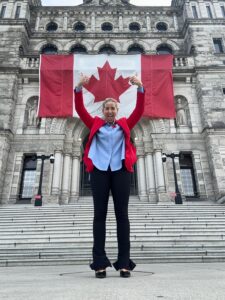Campbell Stuart Johnston, Erika Belanger, Krystal Wong, David Snadden
Correspondence to Dr David Snadden david.snadden@ubc.ca
Published: October 14, 2021
Excerpts from the Abstract
Objectives The objectives of the Rural Site Visit Project (SV Project) were to develop a successful model for engaging all 201 communities in rural British Columbia, Canada, build relationships and gather data about community healthcare issues to help modify existing rural healthcare programs and inform government rural healthcare policy.
Setting The 107 communities visited thus far have healthcare services that range from hospitals with surgical programs to remote communities with no medical services at all. The majority have access to local primary care.
Primary and secondary outcome measures A successful process was developed to engage rural communities in identifying their healthcare priorities, while simultaneously building and strengthening relationships. The qualitative data were analysed from 185 meetings in 80 communities and shared with policy makers at governmental and community levels.
Results 36 themes have been identified and three overarching themes that interconnect all the interviews, namely Relationships, Autonomy and Change Over Time, are discussed.
Conclusion The SV Project appears to be unique in that it is physician led, prioritises relationships, engages all of the healthcare partners singly and jointly in each community, is ongoing, provides feedback to both the policy makers and all interviewees on a 6-monthly basis and, by virtue of its large scope, has the ability to produce interim reports that have helped inform system change.
Excerpts from the Introduction – without footnotes.
British Columba (BC), Canada, has a population of approximately 5 million. About 14% (631 776) are rural citizens distributed unevenly over an area of 944 738 km2. BC is geographically diverse with a broken 27 000 km coastline and extensive mountain ranges that make for long and often dangerous travel, complicated at times by wildfires, floods, avalanches and harsh winter conditions. Access to healthcare services for rural citizens is often limited by the expansive geography, provider availability and transportation issues.
Support programmes for rural physicians in BC are overseen by the Joint Standing Committee on Rural Issues (JSC), a committee comprised of equal numbers of provincial Ministry of Health representatives and rural physicians. The JSC manages approximately C$150M (2020) of funding annually for programmes and projects that improve healthcare delivery in rural BC (JSC Programme Booklet). Some of this work is delivered by the Rural Coordination Centre of BC (RCCbc), which is funded by the JSC to coordinate and improve rural healthcare throughout the province. The RCCbc is a networked organisation that includes many rural physicians and a small number of rural health professionals in its network.
The Rural Site Visits Project (SV Project) was initiated in 2017 by rural physicians with a proposal to the JSC who tasked the RCCbc with visiting 201 rural and Indigenous BC communities identified as eligible for rural benefits under the Rural Practice Subsidiary Agreement (RSA). The RSA is an agreement between the Government of BC and the Doctors of BC (a professional organisation that represents 14 000 physicians, medical residents and medical students in BC).
The purpose of the SV Project was to build relationships between rural physicians, healthcare providers, health administrators, municipal leadership, First Nations leadership, first responders, academia and policy makers through listening and gathering data systematically about local successes, innovations and challenges relating to rural healthcare delivery. These data are guiding the development of JSC programmes and informing government Rural Health Care policy.
In 1978, the declaration of the Alma-Ata International Conference on Primary Health Care stated that: ‘The people have the right and duty to participate individually and collectively in the planning and implementation of their health care’. Current trends in rural health services, however, aim to reduce infrastructure and support to achieve greater efficiencies through centralization of services. Small rural communities have had to be proactive in securing local health services to resist this development,requiring improved relationships and communication between the policy makers and communities.
Community participation has been seen as a more complete approach to health development leading to culturally and contextually appropriate decisions being made about rural health services. Relationship building between stakeholders is also seen as more effective than attempting to provide a myriad of healthcare services, especially as each rural community is unique and ‘one size fits all’ approaches are largely ineffective. While there have been efforts by health service policy makers to align their actions with rural communities’ expressed priorities,the processes used for community engagement have received less attention and descriptions seldom include adequate documentation of the processes involved.
The community engagement literature does not show examples of rural health projects initiated and led by physicians, even though physicians have been key partners in other research on rural community-engaged health services planning.Much of the research on community engagement in rural health service planning has had a specific focus, for example, in improving immunisation programmes in Nigeria or chronic disease care in the Torres Strait Islands. There are some examples of research focused on community participation for broader primary care reform, for example, in the Northern Health Authority region of BC and the Remote Service Futures (RSF) Project in Scotland. The former has resulted in some sustained changes to date, for example the establishment of Primary Care Nurses, improved antenatal care and regional palliative care services.
When the RSF outcomes were reviewed in 2014: ‘Only one direct sustained service change was found’. These raise the question of how best to achieve sustainable beneficial rural health system changes using community engagement processes. The project described here attempts to address this issue. Due to the complex nature of this initiative, it is presented in this article as two components. First, the process of engagement in terms of how communities were engaged and how information was shared with them after the visits. Second, as the data gathering and engagement process are entwined, information on the research methods and broad early results are included to provide a context for future more detailed publications arising from the data.
To access the full report, click on: How can rural community-engaged health services planning achieve sustainable healthcare system changes?
or:
https://bmjopen.bmj.com/content/11/10/e047165.full





